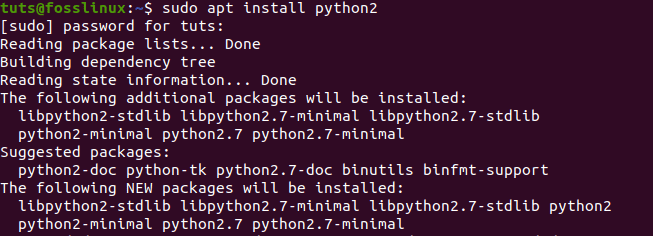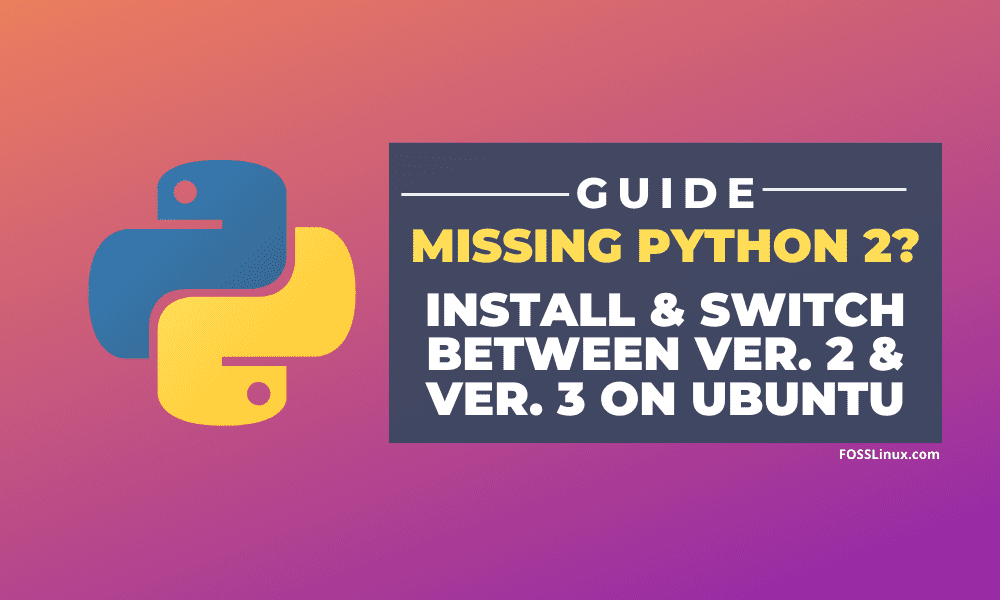In the recent past, there has been a bit of debate on which Python version should one learn. Python 2 or Python 3. It’s now 2020 and pretty evident that Python 3 is the way to go. However, Python 2 is still in the market, and some people, including me, still use it in development. It brings forth the necessity of how we set up and switch between the two versions on your Linux system.
Ubuntu 18.04 LTS release came with several changes, and one is that Python 2 was no longer the default Python version in the system. Welcome, Ubuntu 20.04 LTS release; canonical dropped Python 2 entirely and no longer included it among the installation packages.
See the image below. When we try to execute the Python 2 command, which is by default “python,” we get “command not found” error.

Python 2 not packaged in Ubuntu 20.04
In this post, we will show you how to:
- Install Python 2 in Ubuntu 20.04 LTS
- Switch between Python 3 and Python 2 versions
Installing Python 2 in Ubuntu 20.04 LTS
Step 1) Launch the Terminal and type any of the commands below. You will be required to enter your root password.
$ sudo apt install python2 OR $ sudo apt install python-minimal

Install Python2 in Ubuntu 20.04 LTS
Step 2) Once the installation complete, you can check the Python 2 version using the “–version” command.
python2 --version python3 --version

Check the python version installed
From the image above, we can see we are running Python 2.7 and Python 3.8. Now, let’s jump on to one of the important parts of this tutorial of how to configure Python and switch between the two versions – Python 2 and Python 3.
How to switch between Python 2 and 3 versions on Ubuntu 20.04
Method 1: My recommended way by configuring
Step 1) Check all the available Python versions in your system. To do so, we will need to check the /bin directory. That is because we can have variations in Python 3. Say Python 3.7 and Python 3.8. In such situations, the –version command won’t be useful as it only lists the currently configured version.
Execute the commands below on the Terminal.
ls /usr/bin/python*

Check all the installed Python versions in the bin directory
Step 2) Once we have listed all the versions present on the system, we need to check whether there are any Python-alternatives configured.
Execute the command below on the Terminal.
sudo update-alternatives --list python

Check for any Python alternatives configured on the system
From the image above, we see that there are no Python alternatives configured.
Step 3) Now, we will configure two Python alternatives. From the image in Step 2 above, we saw that I have Python 2.7 and Python 3.8 present on my system.
Execute the commands below on the Terminal.
$ sudo update-alternatives --install /usr/bin/python python /usr/bin/python2 1 $ sudo update-alternatives --install /usr/bin/python python /usr/bin/python3 2

Configure Python Alternatives
Step 4) We need to confirm the Python alternatives set and whether they are in use.
Execute the command below again.
$ sudo update-alternatives --config python

Confirm the Python Alternatives set
On the prompt that appears on the Terminal, enter 1 or 2 to make your selection. In this post, we want to use Python 2; therefore, we will enter option 1.
Step 5) Now, let’s check the Python version currently running on our system. Execute the command below.
python --version

Check the currently running Python Version
To switch to another Python version, all you need to do is execute the command on Step 4 and select the other option. In this case, we would choose option 2 to use Python 3.
Method 2: Old-school way without configuration
This other method, we would refer to it as the manual way since we won’t perform any configurations. Follow the procedure below.
Step 1) Install Python 2 with the command below.
sudo apt install python2
Step 2) Check the Python versions present in your system by running the command below.
ls /usr/bin/python*

Check all the installed Python versions in the bin directory
Step 3) In this post, we currently have Python 2 and Python 3 available. Now write your Python 2 or Python 3 code.
For example, below is a Python 2 code to print the sentence “Hello, This Fosslinux.com.“

Python2 Code
Step 4) To execute your code using Python 2, you will need to specify the version manually. For example, the python file is called Example.py. Execute the command below.
python2 Example.py

Execute the Python 2 code
If we used Python 3 to execute the code below, we would get an error, as shown below.

Error when using Python3 to execute Python2 code
If we were writing code using Python 3, we would specify Python 3 when running the program.
Conclusion
Despite Python 2 being dropped in the recent Linux releases, some people still find it advantageous and use it in their development. There are vast applications built using Python 2, and the transition to Python 3 has not been put into effect fully.
These and many other reasons make Python 2 still relevant in the development community. With the methods described above, you will be able to switch from one Python version to another easily when coding.


10 comments
hello
i’m starting with UBUNTU. i installed 20/04 LTS and get an error message when trying to install python2
sudo apt install python2 start but
reading > ok
dependencies
status information reading > ok
impossible to find python2 paquet.
i have a old school python script that need the 2 and not the 3 !
i tried to upgrade it by changing the print syntax but now experiencing decode_encode issues.
thanks for the help.
additional information : it is 20.04 LTS live version
Currently “sudo apt install python-minimal” should be sudo apt install python2-minimal
I just did a fresh install of Ubuntu 20.04, and both pythons were installed automatically.
In fact there are two packages in ubuntu 20.04 that handle this switch between python2 and python3 as /usr/bin/python: `python-is-python2` and `python-is-python3`. If you install the first your /usr/bin/python will be python2 and for the second it will be python3.
“`
$> apt search python-is-python
Sorting… Done
Full Text Search… Done
python-is-python2/focal,focal 2.7.17-4 all
symlinks /usr/bin/python to the DEPRECATED python2
python-is-python3/focal,focal,now 3.8.2-4 all [installed]
symlinks /usr/bin/python to python3
“`
Thank you for this article. Your claim that the default python in Ubuntu Bionic 18.04 is python3 is incorrect.
https://packages.ubuntu.com/bionic/python
Excellent tutorial!
Great article! 1st method (via configuration) worked well on Ubuntu 20.04.
If the goal is not new development but simply to run existing Python 2 scripts (and possibly occasionaly modify them) is this process even necessary? I’m using Mint MATE (much the same code base as Ubuntu?) which came with 2.7.18 and 3.8.10 installed. With the unmodified stock setup would it be necessary to edit the #! first lines of python 2 modules (“#!/usr/bin/python2”, paralleling what I have long done with python3 code), or even get by with not changing anything at all?
Thank you! This was incredibly helpful for me. I recently upgrade my Linux Mint version to 21.1 and discovered that a python script I use regularly would no longer work without Python 2.7. Now i am able to use that script again thanks to this advice.